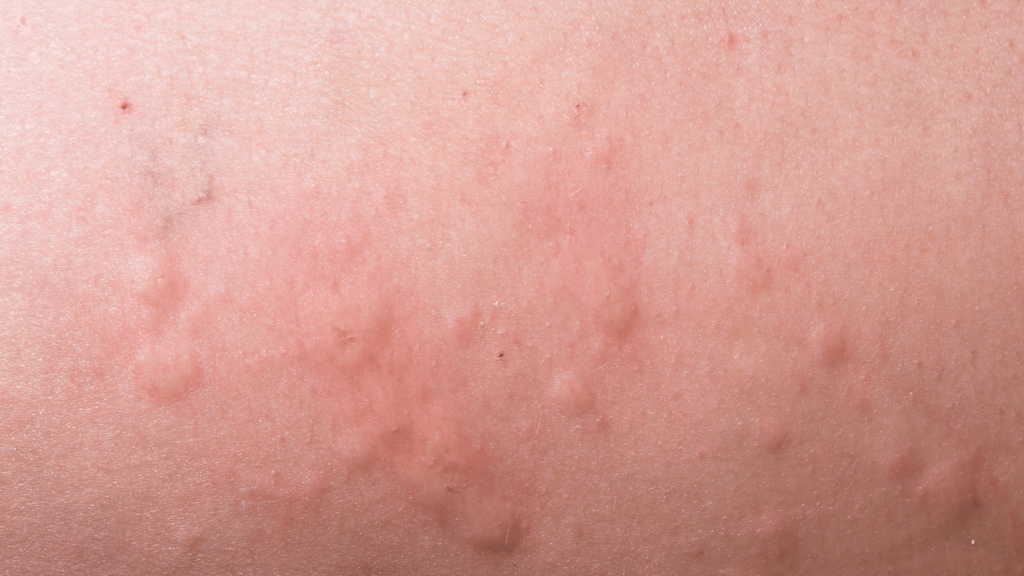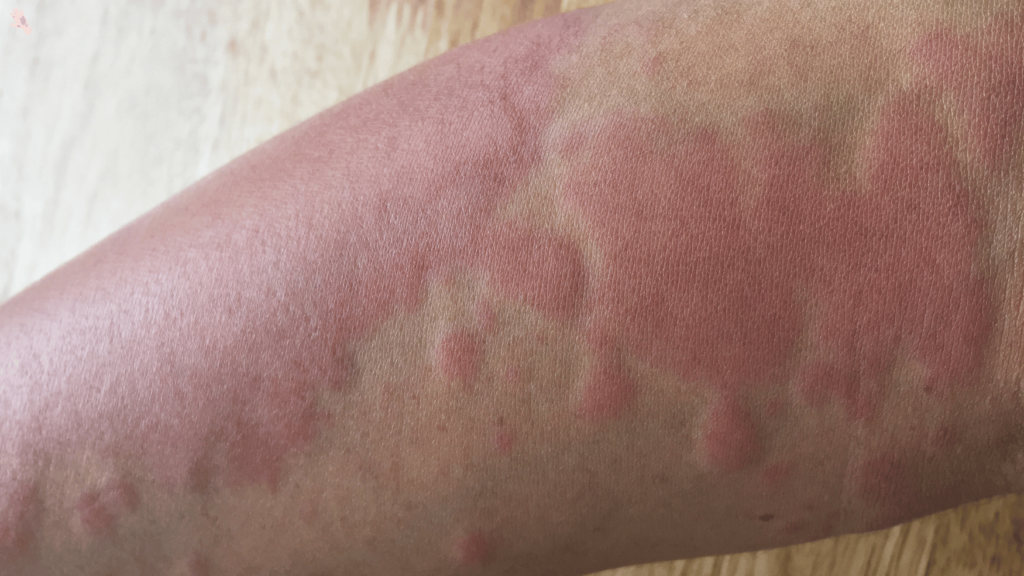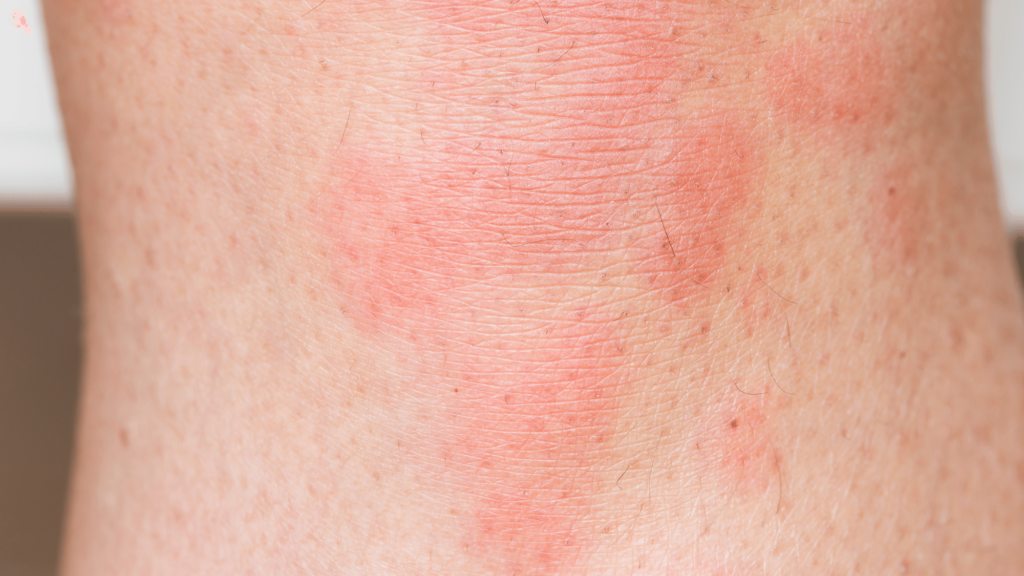Hives, also known as urticaria, are a common skin condition that appears as a sudden outbreak of swollen, pale red bumps or plaques (welts) on the skin. These can appear anywhere on the body and often cause itching. Sometimes, they also burn or sting. Hives occur when the body releases a chemical called histamine in response to an allergic reaction, an infection, stress, or other triggers. This chemical causes blood vessels to leak fluid into the deepest layers of the skin, which results in swelling.
Each hive can last for a few hours before fading away, leaving no marks. However, new hives may form as old ones disappear. If hives persist for more than six weeks, they’re considered chronic and may require further medical evaluation to determine the underlying cause.

what causes hives?
Hives, or urticaria, can be triggered by a variety of factors that cause the body to release histamine, a chemical that leads to swelling and itchiness in the skin. Common triggers include:
- Allergies: Many cases of hives are due to allergic reactions to foods, medications, or other substances. Foods like nuts, shellfish, and eggs, or medications such as antibiotics and aspirin, are frequent culprits.
- Infections: Both viral and bacterial infections can lead to hives. For example, a common cold or a urinary tract infection might trigger an outbreak.
- Stress: Emotional stress and anxiety can also cause hives in some people, as stress can disrupt immune system function and lead to inflammation.
- Environmental factors: Exposure to extreme temperatures, sunlight, or water can cause hives in some individuals.
- Physical stimuli: Physical contact with the skin, such as pressure, scratching, or vibrations, can induce hives in sensitive individuals.
Understanding the specific cause of hives in any individual can sometimes be challenging, as the triggers can vary widely from one person to another. Identifying and avoiding personal triggers is a key step in managing and preventing hives.
What do hives look like?

Hives, medically known as urticaria, appear on the skin as red, raised bumps or welts. They can vary significantly in size, ranging from as small as a pencil eraser to as large as a dinner plate, and they may join together to form larger areas of raised skin. The edges of these welts are typically well-defined, making them stand out against the surrounding skin. Hives can pop up anywhere on the body and often move around, disappearing from one place and reappearing in another, sometimes in a matter of hours. While they are usually very itchy, they can also burn or sting. The skin returns to normal appearance without any markings once the hives resolve.
Types of hives?
Hives, or urticaria, come in different types, each with its own characteristics and triggers. Understanding the various types can help in managing this condition more effectively. Here are the main types of hives:
Acute Urticaria: This type of hives is temporary, lasting less than six weeks, and is the most common form. Outbreaks may be triggered by various factors including foods such as nuts, shellfish, and eggs; medications like antibiotics or aspirin; or environmental allergens like pollen or pet dander. Additionally, viral or bacterial infections and emotional stress are significant triggers. The welts associated with acute urticaria can appear rapidly and often resolve once the allergen is removed or the infection subsides.
Chronic Urticaria: Unlike acute urticaria, chronic hives persist for more than six weeks and often appear daily. The causes of chronic urticaria are more difficult to determine and may involve underlying health issues such as thyroid disease, hormonal imbalances, or autoimmune disorders like lupus. Sometimes, the trigger is never identified. Managing chronic urticaria often requires a combination of lifestyle adjustments, avoidance of known triggers, and medical treatment.
Physical Urticaria: This category is unique because it is triggered by direct physical stimulation of the skin. The types include:
- Pressure Urticaria: Caused by tight clothing, belts, or prolonged sitting.
- Cold Urticaria: Triggered by exposure to cold air or water.
- Heat Urticaria: Occurs due to exposure to hot environments or objects.
- Solar Urticaria: Caused by exposure to sunlight.
- Vibratory Urticaria: Triggered by vibration against the skin. Each type produces welts or redness precisely where the skin has been stimulated.
Dermatographic Urticaria: Known as “skin writing,” this form occurs when minor scratches or consistent rubbing of the skin leads to raised, red lines. This type of urticaria shows how sensitive the skin’s immune response can be, as even towel drying can trigger an outbreak.
Cholinergic Urticaria: This type is related to increased body temperature and is commonly triggered by exercise, hot showers, or emotional stress. It manifests as numerous small, itchy bumps that might develop into a widespread rash during the body’s temperature rise.
Contact Urticaria: This immediate reaction occurs when the skin comes into contact with an allergen. Symptoms can appear within minutes and include redness, itching, and swelling. Common triggers are latex gloves, cosmetics, fragrances, plants, and animal dander. Avoiding direct contact with these allergens is crucial for prevention.
By understanding these types and their triggers, individuals affected by hives can take proactive steps toward managing their symptoms and improving their quality of life.
What are the treatment options for hives?
If you’re dealing with hives, the goal of treatment is to relieve symptoms and prevent them from reoccurring. Here are several effective strategies:
- Antihistamines: These are the most common treatment for hives. Over-the-counter options like cetirizine, fexofenadine, and loratadine can help reduce itching and swelling. For more severe cases, a doctor might prescribe a stronger antihistamine.
- Corticosteroids: For severe or chronic hives, doctors may prescribe corticosteroids to reduce inflammation. These are typically used for short periods due to potential side effects with long-term use.
- Calamine Lotion: Applying calamine lotion can soothe the skin and relieve itching. It’s especially useful for mild cases of hives.
- Cool Compresses: Applying a cool, wet cloth to the affected areas can provide immediate relief from itching and help reduce swelling.
- Avoid Triggers: Identifying and avoiding triggers is crucial. This might involve keeping a food diary, avoiding certain medications, or managing stress.
- Epinephrine: In cases where hives are accompanied by severe allergic reactions, such as difficulty breathing or swelling of the throat, an epinephrine injection (commonly known by the brand name EpiPen) may be necessary. This is a medical emergency.
- Omalizumab (Xolair): For chronic hives that do not respond to antihistamines, this injectable medication can be prescribed. It works by blocking the immune system’s response that causes hives.
- Lifestyle Adjustments: Simple changes like wearing loose clothing, taking lukewarm showers, and using gentle, unscented skin products can also help manage symptoms.
By combining these treatments with guidance from a healthcare provider, most people with hives can effectively manage their condition and reduce occurrences.
Can we prevent hives?

- Identify Triggers: The most effective way to prevent hives is to figure out what triggers them for you. This might involve keeping a diary to note when outbreaks occur and what you ate or were exposed to beforehand. Common triggers include certain foods, medications, and stress.
- Avoid Known Allergens: Once you know what triggers your hives, do your best to avoid these substances. If certain foods cause your hives, try to eliminate them from your diet. If physical factors like heat or cold are the culprits, take precautions like dressing appropriately for the weather or avoiding hot showers.
- Manage Stress: Since stress can trigger hives, finding effective ways to manage stress through techniques like meditation, yoga, or deep breathing exercises can help prevent outbreaks.
- Use Gentle Skin Care Products: Opt for hypoallergenic and fragrance-free soaps, lotions, and detergents to avoid skin irritation.
- Medication Precautions: If a particular medication has triggered your hives in the past, inform your doctor so they can prescribe an alternative. Never stop taking a prescribed medication without consulting your healthcare provider.
- Regular Doctor Visits: If you experience chronic hives, regular check-ups with your doctor can help manage the condition and prevent severe episodes.
Conclusion
Dealing with hives can be uncomfortable and sometimes frustrating, but understanding what they are, what triggers them, and how to treat them can make a big difference. By recognizing the signs early and knowing your personal triggers, you can manage and often prevent outbreaks. Remember, most hives are temporary and manageable with the right care and precautions.
If your hives persist or if you experience symptoms like difficulty breathing or swelling around the throat, seek medical attention immediately as these could be signs of a more serious reaction. For chronic or recurrent hives, working closely with a healthcare provider is crucial to develop an effective treatment plan.
Hives don’t have to disrupt your life. With some knowledge and proactive management, you can maintain your comfort and well-being. Keep these tips in mind, and take control of your skin health today!



